Govt. of India is promoting Archaeological tourism or Archaeotourism for the conservation of historical sites as well as to promote public interest in archaeology. This includes visits to archaeological sites, museums, archaeological awareness centers, replica of historical occurrences, and the rediscovery of indigenous products, festivals, or theaters. Archaeological Tourism also promotes an area’s cultural heritage. Holiday rental properties such as cottages, homestays, bed & breakfast, resorts, apartments, etc are increasing in number day by day in India near these excavation sites. These help the tourists visiting India from outside as well as the local Indian tourists to spend their holidays safe and comfortable near to these interesting excavation sites thereby promoting Archaeotourism.
| Archaeological Sites | State |
| Agra Fort | Uttar Pradesh |
| Ajanta Caves | Maharashtra |
| Ambari | Assam |
| Bhimbetka | Madhya Pradesh |
| Brihadeeswarar Temple, Thanjavur | Tamil Nadu |
| Champaner | Gujarat |
| Churches and Convents of Goa | Old Goa |
| Dholavira | Gujarat |
| Didwana | Rajasthan |
| Fatehpur Sikri | Uttar Pradesh |
| Hampi | Karnataka |
| Humayun’s Tomb | Delhi |
| Hunsgi | Karnataka |
| Inamgaon | Maharashtra |
| Jantar Mantar, Jaipur | Rajasthan |
| Kuliana | Orissa |
| Madhura | Uttar Pradesh |
| Mahabalipuram | Tamil Nadu |
| Mahabodhi Temple Bodh Gaya | Bihar |
| Nalanda | Bihar |
| Pallavaram | Tamil Nadu |
| Pattadakal | Karnataka |
| Qutb Minar | Delhi |
| Sanchi | Madhya Pradesh |
| Sun Temple, Konark | Orissa |
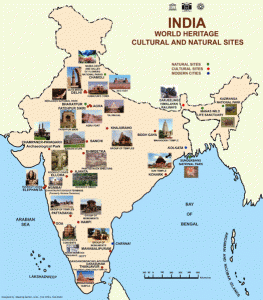 World Heritage Sites of India[/caption]
The archaeological sites in India are mainly classified according to the period they belong such as Stone Age, Indus Valley, Neolithic-Chalcolithic, Megalithic-Early Historic and Late Historic periods. The famous archaeological sites of the Stone Age are Pallavaram in Tamil Nadu, Hunsgi in Karnataka, Kuliana in Orissa, Didwana in Rajasthan, and Bhimbetka in Madhya Pradesh. Those of Neolithic-Chalcolithic Age are Inamgaon, Walki, Navdatoli, Ahar, Balathal, Gilund, Budhihal, Sangankalur, Maski, Brahmagiri, Utnur, Golbai, Pandu-Rajar-Dhibi, Chirand and Burzoham etc. Famous sites of Indus Valley Civilisation are Indus and Ghaggar river valleys, Kutch and Saurashtra, Dholavira, Kalibangan, Lothal, Surkotda and Rakhigari. Famous sites of Megalithic period are Brahmagiri, Maski and Rajan Kalur, Bhagimari, Gadabas etc. Excavations at Kosambi, Saranath, Hastinapura, Vaishali, Rajgir and Bodh Gaya, Chandraketugarh, Sisupalgarh etc. have revealed fortified cities dating back to this period. Famous sites of Buddhist Phase are Sanchi, Saranath, Ajanta, Kaneheri, Amravati, Sanati and Lalitgiri. The sites of Jainism Phase are Khandagiri-Udayagiri, Mathura. The Islamic Archaeological sites in India are Delhi, Agra, Lucknow, Hyderabad, northern Karnataka, Aurangabad, and Bhopal. Another famous archaeological site is Nalanda, Bihar.
[caption id="attachment_140" align="alignnone" width="300"]
World Heritage Sites of India[/caption]
The archaeological sites in India are mainly classified according to the period they belong such as Stone Age, Indus Valley, Neolithic-Chalcolithic, Megalithic-Early Historic and Late Historic periods. The famous archaeological sites of the Stone Age are Pallavaram in Tamil Nadu, Hunsgi in Karnataka, Kuliana in Orissa, Didwana in Rajasthan, and Bhimbetka in Madhya Pradesh. Those of Neolithic-Chalcolithic Age are Inamgaon, Walki, Navdatoli, Ahar, Balathal, Gilund, Budhihal, Sangankalur, Maski, Brahmagiri, Utnur, Golbai, Pandu-Rajar-Dhibi, Chirand and Burzoham etc. Famous sites of Indus Valley Civilisation are Indus and Ghaggar river valleys, Kutch and Saurashtra, Dholavira, Kalibangan, Lothal, Surkotda and Rakhigari. Famous sites of Megalithic period are Brahmagiri, Maski and Rajan Kalur, Bhagimari, Gadabas etc. Excavations at Kosambi, Saranath, Hastinapura, Vaishali, Rajgir and Bodh Gaya, Chandraketugarh, Sisupalgarh etc. have revealed fortified cities dating back to this period. Famous sites of Buddhist Phase are Sanchi, Saranath, Ajanta, Kaneheri, Amravati, Sanati and Lalitgiri. The sites of Jainism Phase are Khandagiri-Udayagiri, Mathura. The Islamic Archaeological sites in India are Delhi, Agra, Lucknow, Hyderabad, northern Karnataka, Aurangabad, and Bhopal. Another famous archaeological site is Nalanda, Bihar.
[caption id="attachment_140" align="alignnone" width="300"]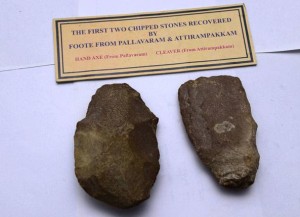 Stones Recovered from Pallavaram[/caption]
Pallavaram, original name is Pallava Puram. This is a town in Chennai, which forms a part of the Tambaram taluk of Kanchipuram district of Tamil Nadu. This is one of the oldest cities of South India. From here, in 1864 a stone implement from the Paleolithic Age was discovered inside a balanced pit.
[caption id="attachment_141" align="alignnone" width="215"]
Stones Recovered from Pallavaram[/caption]
Pallavaram, original name is Pallava Puram. This is a town in Chennai, which forms a part of the Tambaram taluk of Kanchipuram district of Tamil Nadu. This is one of the oldest cities of South India. From here, in 1864 a stone implement from the Paleolithic Age was discovered inside a balanced pit.
[caption id="attachment_141" align="alignnone" width="215"]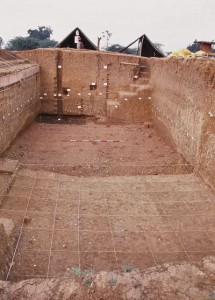 Excavation Site in Hunsgi[/caption]
Hunasagi or Hunsgi is a village of Yadgir district in Karnataka. This village belongs to late stage Old Stone Age and excavations from here found stone tools and weapons made from a reddish brown microfibrous sedimentary rock.
[caption id="attachment_142" align="alignnone" width="300"]
Excavation Site in Hunsgi[/caption]
Hunasagi or Hunsgi is a village of Yadgir district in Karnataka. This village belongs to late stage Old Stone Age and excavations from here found stone tools and weapons made from a reddish brown microfibrous sedimentary rock.
[caption id="attachment_142" align="alignnone" width="300"]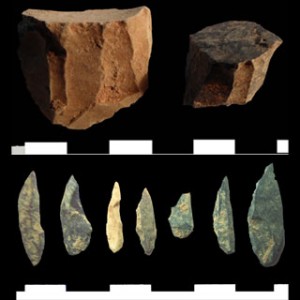 Stone Weapons Recovered from Kuliana[/caption]
Kuliana in Orissa is situated at a distance of 18 km from Baripada. Excavations here have found out several palaeolithic devices.
[caption id="attachment_143" align="alignnone" width="300"]
Stone Weapons Recovered from Kuliana[/caption]
Kuliana in Orissa is situated at a distance of 18 km from Baripada. Excavations here have found out several palaeolithic devices.
[caption id="attachment_143" align="alignnone" width="300"]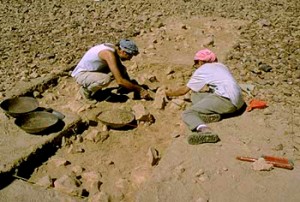 Excavation Site in Didwana[/caption]
Didwana is a 5000 years old town in Rajasthan. This has a long history of great teachers who have taken the Hindu religion a long way.
[caption id="attachment_144" align="alignnone" width="300"]
Excavation Site in Didwana[/caption]
Didwana is a 5000 years old town in Rajasthan. This has a long history of great teachers who have taken the Hindu religion a long way.
[caption id="attachment_144" align="alignnone" width="300"]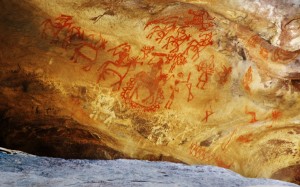 Bhimbetka Rock Paintings[/caption]
Bhimbetka is located in the Raisen District of Madhya Pradesh. From here, Stone Age rock paintings have been excavated. The Bhimbetka rock shelters are approximately 30,000 years old. The Bhimbetka caves also deliver early evidence of dance. UNESCO has declared this a World Heritage Site.
[caption id="attachment_145" align="alignnone" width="300"]
Bhimbetka Rock Paintings[/caption]
Bhimbetka is located in the Raisen District of Madhya Pradesh. From here, Stone Age rock paintings have been excavated. The Bhimbetka rock shelters are approximately 30,000 years old. The Bhimbetka caves also deliver early evidence of dance. UNESCO has declared this a World Heritage Site.
[caption id="attachment_145" align="alignnone" width="300"]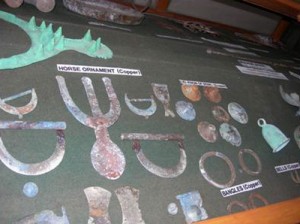 Inamgaon[/caption]
Inamgaon is a village located in Pune District of Maharashtra. The excavations made here disclosed multiple cultural phases including Late Jorwe Culture, Early Jorwe Culture, and Malwa Culture.
Inamgaon[/caption]
Inamgaon is a village located in Pune District of Maharashtra. The excavations made here disclosed multiple cultural phases including Late Jorwe Culture, Early Jorwe Culture, and Malwa Culture.
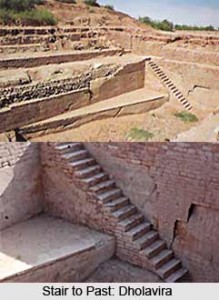 Dholavira is in Kutch District of Gujarat. The excavations here unearthed several antiquities and also brought to light the urban planning and architecture existed in the ancient period
Dholavira is in Kutch District of Gujarat. The excavations here unearthed several antiquities and also brought to light the urban planning and architecture existed in the ancient period
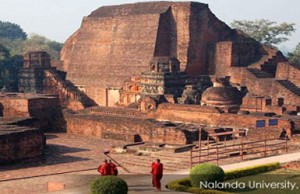 Nalanda in Bihar is an ancient center of higher learning during the Pala period in India. This archaeological site is located about 88 kilometres south east of Patna. The ruins of this university occupy an area of 14 hectares.
[caption id="attachment_148" align="alignnone" width="300"]
Nalanda in Bihar is an ancient center of higher learning during the Pala period in India. This archaeological site is located about 88 kilometres south east of Patna. The ruins of this university occupy an area of 14 hectares.
[caption id="attachment_148" align="alignnone" width="300"]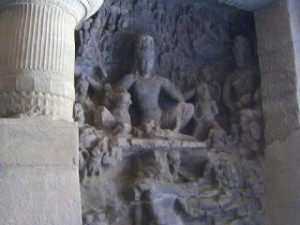 Elephanta Caves[/caption]
Ajanta, the place is famous for the Elephanta caves or Ajanta caves. This is a UNESCO World Heritage Site in Maharashtra. The caves excavated from here are carved out of a solid rock. Here you can see some of the most impressive statues of Lord Shiva, a major Hindu deity in Hinduism, in his various forms and avatars.
[caption id="attachment_138" align="alignnone" width="300"]
Elephanta Caves[/caption]
Ajanta, the place is famous for the Elephanta caves or Ajanta caves. This is a UNESCO World Heritage Site in Maharashtra. The caves excavated from here are carved out of a solid rock. Here you can see some of the most impressive statues of Lord Shiva, a major Hindu deity in Hinduism, in his various forms and avatars.
[caption id="attachment_138" align="alignnone" width="300"]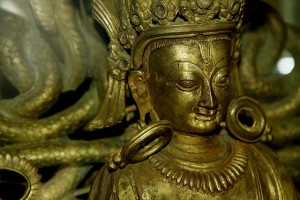 Buddha's Statue unearthed from Mathura[/caption]
Madhura is situated about 11 kilometers from the town of Vrindavan in the state of Uttar Pradesh. In Mathura Archaeological Museum located in Dampier Park, you will be able to see the items discovered in the archeological excavations from Mathura and adjacent area. The museum houses nearly 6000 stone sculptures, 400 paintings, 3000 terracotta figures and 350 metal figures.
[caption id="attachment_149" align="alignnone" width="300"]
Buddha's Statue unearthed from Mathura[/caption]
Madhura is situated about 11 kilometers from the town of Vrindavan in the state of Uttar Pradesh. In Mathura Archaeological Museum located in Dampier Park, you will be able to see the items discovered in the archeological excavations from Mathura and adjacent area. The museum houses nearly 6000 stone sculptures, 400 paintings, 3000 terracotta figures and 350 metal figures.
[caption id="attachment_149" align="alignnone" width="300"]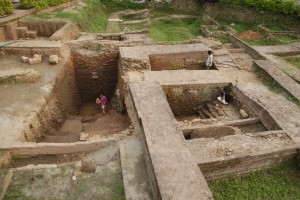 Tank with stairs excavated from Ambari[/caption]
Ambari is an archaeological site situated in District of Assam. The most important discovery of the excavations done here is the flight of steps made of bricks leading to the tank. Archaeologists also found out two floors and two hearths resting on the natural soil significantly.
[caption id="attachment_153" align="alignnone" width="213"]
Tank with stairs excavated from Ambari[/caption]
Ambari is an archaeological site situated in District of Assam. The most important discovery of the excavations done here is the flight of steps made of bricks leading to the tank. Archaeologists also found out two floors and two hearths resting on the natural soil significantly.
[caption id="attachment_153" align="alignnone" width="213"]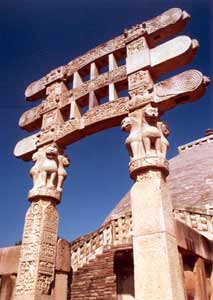 Sanchi[/caption]
Sanchi is a small village in Raisen District of Madhya Pradesh. The place is famous for stupas, monolithic Asokan pillar, temples, monasteries and sculptural wealth. Emperor Asoka erected the Great Stupa here inorder to spread Buddhism. The stupa was modified, enlarged and faced with stones and decorated with balustrades, staircases and a harmika on the top during the Sunga times. Now excavations here in Sanchi and Satdhara a nereby Buddhist site is progressing under a UNESCO project.
[caption id="attachment_154" align="alignnone" width="128"]
Sanchi[/caption]
Sanchi is a small village in Raisen District of Madhya Pradesh. The place is famous for stupas, monolithic Asokan pillar, temples, monasteries and sculptural wealth. Emperor Asoka erected the Great Stupa here inorder to spread Buddhism. The stupa was modified, enlarged and faced with stones and decorated with balustrades, staircases and a harmika on the top during the Sunga times. Now excavations here in Sanchi and Satdhara a nereby Buddhist site is progressing under a UNESCO project.
[caption id="attachment_154" align="alignnone" width="128"]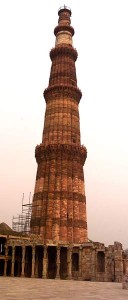 Qutb-Minar[/caption]
Qutb-Minar located in Delhi in red and tawny standstone is the highest tower in India. The foundation of the Minar was laid by Qutbu'd-Din Aibak in AD 1199. There are numerous inscriptions in Arabic and Nagari characters in different places of the minar revealing the history of Qutb. There is a mosque to the north-east of minar Quwwat-ul-Islam which was built by the Delhi Sultans in AD 1198. In the main entrance there is an inscription and in that it is written that the mosque consists of a rectangular courtyard enclosed by secluded religious places, erected with the carved columns and architectural members of 27 Hindu and Jaina temples which were demolished by Qutbu'd-Din Aibak. There is an iron pillar in the courtyard bearing an inscription in Brahmi script according to which the pillar was set up as a Vishnudhvaja or standard of God Vishnu. In the tomb of Iltutmish you can a plain square chamber of red sandstone, profusely carved with inscriptions, geometrical and arabesque patterns in Saracenic tradition. Here you can also see the ancient Hindu designs.
[caption id="attachment_156" align="alignnone" width="300"]
Qutb-Minar[/caption]
Qutb-Minar located in Delhi in red and tawny standstone is the highest tower in India. The foundation of the Minar was laid by Qutbu'd-Din Aibak in AD 1199. There are numerous inscriptions in Arabic and Nagari characters in different places of the minar revealing the history of Qutb. There is a mosque to the north-east of minar Quwwat-ul-Islam which was built by the Delhi Sultans in AD 1198. In the main entrance there is an inscription and in that it is written that the mosque consists of a rectangular courtyard enclosed by secluded religious places, erected with the carved columns and architectural members of 27 Hindu and Jaina temples which were demolished by Qutbu'd-Din Aibak. There is an iron pillar in the courtyard bearing an inscription in Brahmi script according to which the pillar was set up as a Vishnudhvaja or standard of God Vishnu. In the tomb of Iltutmish you can a plain square chamber of red sandstone, profusely carved with inscriptions, geometrical and arabesque patterns in Saracenic tradition. Here you can also see the ancient Hindu designs.
[caption id="attachment_156" align="alignnone" width="300"]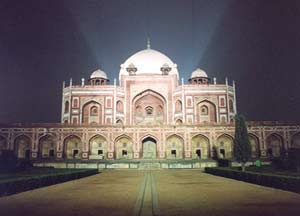 Humayun’s Tomb[/caption]
Humayun’s Tomb in Delhi was constructed by his wife Hamida Banu Begam in 1569. The tomb is the best example of distinct Mughal style. Barber's tomb is on the southwest side of this tomb.
[caption id="attachment_161" align="alignnone" width="300"]
Humayun’s Tomb[/caption]
Humayun’s Tomb in Delhi was constructed by his wife Hamida Banu Begam in 1569. The tomb is the best example of distinct Mughal style. Barber's tomb is on the southwest side of this tomb.
[caption id="attachment_161" align="alignnone" width="300"]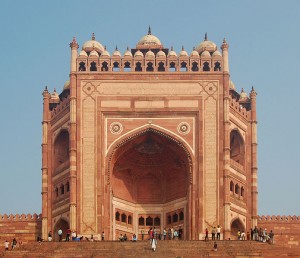 Fatehpur Sikri[/caption]
Fatehpur Sikri is a city in Agra district of Uttar Pradesh. This is one of the best examples of Mughal architecture in India. All the buildings here are made of red stone. Buildings here show excellence of architectural craftsmans of various regional schools such as Gujarat and Bengal. Here you will also be able to see the Hindu & Jain architecture along with Islamic elements.
[caption id="attachment_168" align="alignnone" width="259"]
Fatehpur Sikri[/caption]
Fatehpur Sikri is a city in Agra district of Uttar Pradesh. This is one of the best examples of Mughal architecture in India. All the buildings here are made of red stone. Buildings here show excellence of architectural craftsmans of various regional schools such as Gujarat and Bengal. Here you will also be able to see the Hindu & Jain architecture along with Islamic elements.
[caption id="attachment_168" align="alignnone" width="259"]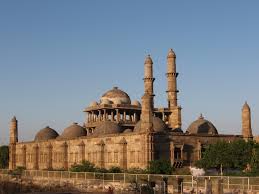 Champaner[/caption]
Champaner is located at the foothills of the Pavagadh hill in Gujarat. This hill is one of the oldest rock formations in India. This is composed of reddish-yellow coloured stone formation. This was a famous Hindu fortress under the Solanki kings of Gujarat. The monuments here are located on the Mauliya plateau, which is situated on the hill. Here you can also see temples dedicated to Hindu & Jaina deities. All the temples are of the Nagara style & have garbhagriha, mandapa and an entrance porch. Five mosques here are still in good condition out of the massive destruction. The structures here represent a perfect blend of Hindu-Moslem architecture. You can see this mainly in the Great Mosque (Jami Masjid). The Champaner-Pavagadh Archaeological Park here surely represents cultures which have disappeared.
[caption id="attachment_169" align="alignnone" width="259"]
Champaner[/caption]
Champaner is located at the foothills of the Pavagadh hill in Gujarat. This hill is one of the oldest rock formations in India. This is composed of reddish-yellow coloured stone formation. This was a famous Hindu fortress under the Solanki kings of Gujarat. The monuments here are located on the Mauliya plateau, which is situated on the hill. Here you can also see temples dedicated to Hindu & Jaina deities. All the temples are of the Nagara style & have garbhagriha, mandapa and an entrance porch. Five mosques here are still in good condition out of the massive destruction. The structures here represent a perfect blend of Hindu-Moslem architecture. You can see this mainly in the Great Mosque (Jami Masjid). The Champaner-Pavagadh Archaeological Park here surely represents cultures which have disappeared.
[caption id="attachment_169" align="alignnone" width="259"]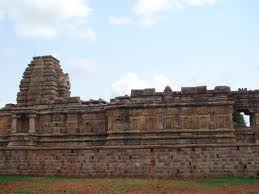 Pattadakal[/caption]
Pattadakal is located in Bijapur district of Karnataka. This was famous for Chalukya architectures and also a holy place for royal crowning 'Pattadakisuvolal'. The temples constructed here is a blend of the Rekha, Nagara, Prasada and the Dravida Vimana styles of temple building.
[caption id="attachment_170" align="alignnone" width="300"]
Pattadakal[/caption]
Pattadakal is located in Bijapur district of Karnataka. This was famous for Chalukya architectures and also a holy place for royal crowning 'Pattadakisuvolal'. The temples constructed here is a blend of the Rekha, Nagara, Prasada and the Dravida Vimana styles of temple building.
[caption id="attachment_170" align="alignnone" width="300"]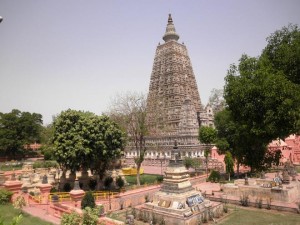 Mahabodhi Temple[/caption]
Bodh Gaya is a religious site in the Gaya district of Bihar. The sacred Bodhi tree under which Lord buddha is believed to have attained enlightenment is here. The place is highly honored by the Buddhists. Emperor Asoka constructed a small temple near the Bodhi tree. An inscription here also mentions that the temple of Asoka was replaced by a new one. On the west of the temple is the sacred Bodhi tree.
[caption id="attachment_171" align="alignnone" width="300"]
Mahabodhi Temple[/caption]
Bodh Gaya is a religious site in the Gaya district of Bihar. The sacred Bodhi tree under which Lord buddha is believed to have attained enlightenment is here. The place is highly honored by the Buddhists. Emperor Asoka constructed a small temple near the Bodhi tree. An inscription here also mentions that the temple of Asoka was replaced by a new one. On the west of the temple is the sacred Bodhi tree.
[caption id="attachment_171" align="alignnone" width="300"]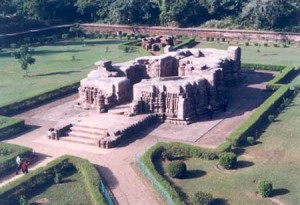 Konarak - Sun Temple[/caption]
Konarak - Sun Temple is in Orissa. Here you can see a gigantic solar chariot with twelve pairs of beautifully-ornamented wheels dragged by seven rearing horses. The temple comprised a sanctum with a high sikhara, a jagamohana and a detached nata-mandira in the same axis, besides numerous subsidiary shrines. The sanctum has superb images of the Sun-god in the three projections which are treated as miniature shrines. To the west of the main temple is the Mayadevi Temple believed to have been one of the wives of Lord Surya. A temple facing east in south-west corner of the compound was discovered during the sand clearance in 1956 known as Vaishnava Temple. From here images of Balarama and two parsvadevatas of Varaha and Trivikrama were unearthed.
[caption id="attachment_172" align="alignnone" width="300"]
Konarak - Sun Temple[/caption]
Konarak - Sun Temple is in Orissa. Here you can see a gigantic solar chariot with twelve pairs of beautifully-ornamented wheels dragged by seven rearing horses. The temple comprised a sanctum with a high sikhara, a jagamohana and a detached nata-mandira in the same axis, besides numerous subsidiary shrines. The sanctum has superb images of the Sun-god in the three projections which are treated as miniature shrines. To the west of the main temple is the Mayadevi Temple believed to have been one of the wives of Lord Surya. A temple facing east in south-west corner of the compound was discovered during the sand clearance in 1956 known as Vaishnava Temple. From here images of Balarama and two parsvadevatas of Varaha and Trivikrama were unearthed.
[caption id="attachment_172" align="alignnone" width="300"]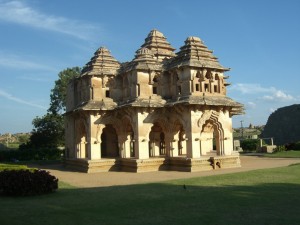 Hampi[/caption]
Hampi is a village belonging to the Bellary District of Northern Karnataka. It is located within the ruins of Vijayanagara. The place is recognized by UNESCO as a World Heritage Site. Hampi was noted for wonderful palaces, holy temples, gigantic forts, markets, big pavilions, and stables of royal elephants. The place is an abode of architecture and culture with lot of ancient temples and monuments. Hampi without visiting Vijaya Vitthala Temple is incomplete. It is under maintenance and some part is inaccessible but a very good complex. The musical pillars of this temple are seen to be believed. They uniquely emit the sounds of whatever musical instrument is advertised on them. The chariot outside the temple is a marvel too. The Virupaksha Temple in Hampi, is noted for its architecture and has been listed among the UNESCO World Heritage Sites.
[caption id="attachment_173" align="alignnone" width="297"]
Hampi[/caption]
Hampi is a village belonging to the Bellary District of Northern Karnataka. It is located within the ruins of Vijayanagara. The place is recognized by UNESCO as a World Heritage Site. Hampi was noted for wonderful palaces, holy temples, gigantic forts, markets, big pavilions, and stables of royal elephants. The place is an abode of architecture and culture with lot of ancient temples and monuments. Hampi without visiting Vijaya Vitthala Temple is incomplete. It is under maintenance and some part is inaccessible but a very good complex. The musical pillars of this temple are seen to be believed. They uniquely emit the sounds of whatever musical instrument is advertised on them. The chariot outside the temple is a marvel too. The Virupaksha Temple in Hampi, is noted for its architecture and has been listed among the UNESCO World Heritage Sites.
[caption id="attachment_173" align="alignnone" width="297"]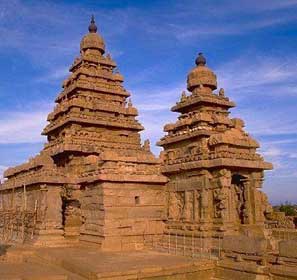 Mahabalipuram[/caption]
Mahabalipuram or Mamallapuram is a town in Kancheepuram district of Tamil Nadu. This was a sea port in the ancient times. Excavations made here unearthed the monuments like rock-cut rathas, sculptured scenes on open rocks like Arjuna's penance, the caves of Govardhanadhari and Mahishasuramardini, the Jala-Sayana Perumal temple (the sleeping Mahavishnu or Chakrin at the rear part of the Shore temple complex). Nine monolithic temples were found out from here. The most important among them are Five Rathas known after the famous five Pandava brothers of the Mahabharata fame. These monuments are carved out of a single rock. There is a shore temple here which is a complex of three temples, ie; Rajasimhesvara, the Kshatriyasimhesvara and Nripatisimha Pallava Vishnugriha housing the lying Vishnu. These shrines are enclosed by two prakara walls. The inner surface of prakara walls once contained panel sculptures which are now deteriorated. The cave temples here are the Varaha mandapa, Mahisamardini mandapa, Paramesvara Mahavaraha Vishnugriha. These temples are constructed in Mamalla style. Rock-cut figures representing religious themes of period have been discovered from the shore temple recently. A stepped ghat facing the sea has also been excavated from here. A lying image of Vishnu, the base of Durga shrine with deer and a square socket possibly to accommodate mahastambha have also been excavated.
[caption id="attachment_174" align="alignnone" width="300"]
Mahabalipuram[/caption]
Mahabalipuram or Mamallapuram is a town in Kancheepuram district of Tamil Nadu. This was a sea port in the ancient times. Excavations made here unearthed the monuments like rock-cut rathas, sculptured scenes on open rocks like Arjuna's penance, the caves of Govardhanadhari and Mahishasuramardini, the Jala-Sayana Perumal temple (the sleeping Mahavishnu or Chakrin at the rear part of the Shore temple complex). Nine monolithic temples were found out from here. The most important among them are Five Rathas known after the famous five Pandava brothers of the Mahabharata fame. These monuments are carved out of a single rock. There is a shore temple here which is a complex of three temples, ie; Rajasimhesvara, the Kshatriyasimhesvara and Nripatisimha Pallava Vishnugriha housing the lying Vishnu. These shrines are enclosed by two prakara walls. The inner surface of prakara walls once contained panel sculptures which are now deteriorated. The cave temples here are the Varaha mandapa, Mahisamardini mandapa, Paramesvara Mahavaraha Vishnugriha. These temples are constructed in Mamalla style. Rock-cut figures representing religious themes of period have been discovered from the shore temple recently. A stepped ghat facing the sea has also been excavated from here. A lying image of Vishnu, the base of Durga shrine with deer and a square socket possibly to accommodate mahastambha have also been excavated.
[caption id="attachment_174" align="alignnone" width="300"]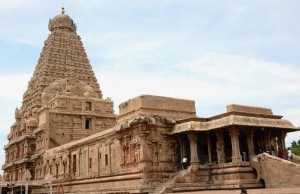 Brihadeeswara Temple[/caption]
Brihadeeswara Temple is located in Thanjavur district of Tamil Nadu. This is the supreme creation of the Chola emperor Rajaraja. This temple’s architecture is regarded as a ‘landmark in the evolution of building art in south India’ and its vimana as a ‘touchstone of Indian architecture’. The temple is dedicated to Lord Shiva. The temple with its massive proportions and simplicity of design has gained attraction not only in south India but also in south-east Asia. The entire temple structure is made out of granite. There is a big statue of Nandi carved out of a single rock, at the entrance.
Archaeological excavations done in Old Goa revealed the most comprehensive group of churches and cathedrals built during 16th to 17th century AD. They include; Se' Cathedral, Church and Convent of St. Francis of Assisi, Chapel of St. Catherine, Basilica of Bom Jesus, Church of Lady of Rosary & Church of St. Augustine. The statues except a few which are in stone, were in wood delicately carved and painted to adorn the altars.
I have listed above some of the archaeological sites in India. As part of tourism promotion, Govt. of India is encouraging the upcoming of holiday rental properties near to these World Heritage Sites giving priority to the safe stay of tourists visiting our country. Come explore & enjoy India.
Brihadeeswara Temple[/caption]
Brihadeeswara Temple is located in Thanjavur district of Tamil Nadu. This is the supreme creation of the Chola emperor Rajaraja. This temple’s architecture is regarded as a ‘landmark in the evolution of building art in south India’ and its vimana as a ‘touchstone of Indian architecture’. The temple is dedicated to Lord Shiva. The temple with its massive proportions and simplicity of design has gained attraction not only in south India but also in south-east Asia. The entire temple structure is made out of granite. There is a big statue of Nandi carved out of a single rock, at the entrance.
Archaeological excavations done in Old Goa revealed the most comprehensive group of churches and cathedrals built during 16th to 17th century AD. They include; Se' Cathedral, Church and Convent of St. Francis of Assisi, Chapel of St. Catherine, Basilica of Bom Jesus, Church of Lady of Rosary & Church of St. Augustine. The statues except a few which are in stone, were in wood delicately carved and painted to adorn the altars.
I have listed above some of the archaeological sites in India. As part of tourism promotion, Govt. of India is encouraging the upcoming of holiday rental properties near to these World Heritage Sites giving priority to the safe stay of tourists visiting our country. Come explore & enjoy India.
